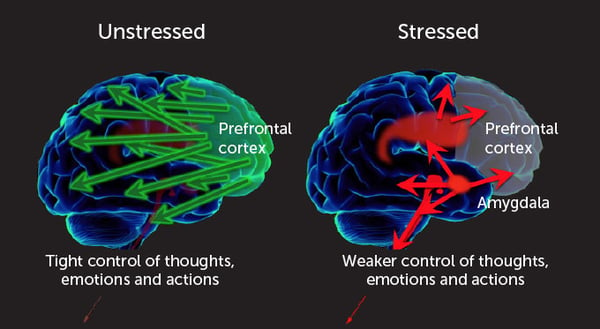We’d all like to think that we are rational thinkers and decision-makers most of the time. We’re not. But it’s not really our fault. It’s the way the brain is designed.
The brain’s primary job is to keep us alive. It constantly scans the environment to identify and respond to threats and opportunities. It’s our ancestral hand-me-down and it’s what has enabled us to survive extinction.
Because our survival depends on our ability to make predictions, and a primary goal of the brain is to predict how to minimize threats and maximize rewards. This is why uncertainty is unsettling. Stress occurs when the brain perceives a threat. But not all threats are created equal.
Level 1 threats are those that don’t pose an immediate danger but the brain is aware that there is the potential for harm.
Level 2 threats are more significant but there is still the possibility that you can evade harm.
When the brain perceives an immediate and significant danger, it registers as a level 3 threat. The sympathetic nervous system activates the fight or flight response. Cortisol and other stress hormones are released and physiological changes occur throughout the body to deal with the threat such as an increased heart rate, dilated bronchial passages, and restricted blood vessels to increase oxygen to the lungs and blood flow to muscles. When you’re stressed and feel your mouth go dry and your palms become sweaty, you’re experiencing the sympathetic nervous system at work.
Simply, our brains are not built to do complex thinking, planning and remembering while experiencing heightened stress. Decades of research shows how stress saps our ability to perform complex cognitive processes. The hub of executive activity is the prefrontal cortex, which handles abstract thinking, planning, focusing, juggling multiple bits of information and impulse control. Even mild stress impairs the neural connectivity of the prefrontal cortex with the rest of the brain.

Functional MRI scans showed thatunder stress, the students’ prefrontal connections to other brain areas were diminished, scientists reported inProceedings of the National Academy of Sciences in 2009.
Luckily, there are some simple strategies that will keep your thinking brain in charge and reduce the chance of inaccurately sounding the Level 3 alarm.
- Increase your sense of control by decreasing your sense of uncertainty. There are many things over which we have no control. It’s easy to get caught in the negative feedback loop of the “what-ifs of the unknowns.” Focus on that which you can control. Intentional acts of kindness, maintaining a daily routine, making good food choices, and taking time to exercise all help create a sense of control and will disrupt the negative thought cycle.
- Connect with others who care about you. We are social creatures who are wired to connect. Schedule coffee, lunch, or a weekend walk with someone you trust. Putting an enjoyable activity on your calendar gives you something positive to focus on in the future. Looking ahead at something positive takes your focus off the uncertainties of the present.
- Imagine your friend is sharing the worries in your head with you. Address the worries as if you’re advising that friend. When you’re in the weeds, all you can see is the weeds. It’s easier to think objectively when we have a little distance from the concern.
- Acknowledge the stress,
- Recognize that we stress over things we value,
- Figure out how to use stress to our advantage.










